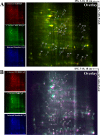Cell extract-containing medium for culture of intracellular fastidious bacteria
- PMID: 23740722
- PMCID: PMC3719666
- DOI: 10.1128/JCM.00719-13
Cell extract-containing medium for culture of intracellular fastidious bacteria
Abstract
The culture of fastidious microorganisms is a critical step in infectious disease studies. As a proof-of-concept experiment, we evaluated an empirical medium containing eukaryotic cell extracts for its ability to support the growth of Coxiella burnetii. Here, we demonstrate the exponential growth of several bacterial strains, including the C. burnetii Nine Mile phase I and phase II strains, and C. burnetii isolates from humans and animals. Low-oxygen-tension conditions and the presence of small hydrophilic molecules and short peptides were critical for facilitating growth. Moreover, bacterial antigenicity was conserved, revealing the potential for this culture medium to be used in diagnostic tests and in the elaboration of vaccines against C. burnetii. We were also able to grow the majority of previously tested intracellular and fastidious bacterial species, including Tropheryma whipplei, Mycobacterium bovis, Leptospira spp., Borrelia spp., and most putative bioterrorism agents. However, we were unable to culture Rickettsia africae and Legionella spp. in this medium. The versatility of this medium should encourage its use as a replacement for the cell-based culture systems currently used for growing several facultative and putative intracellular bacterial species.
Figures





References
-
- Singh S, Eldin C, Kowalczewska M, Raoult D. 2013. Axenic culture of fastidious and intracellular bacteria. Trends Microbiol. 21:92–99 - PubMed
-
- Renesto P, Crapoulet N, Ogata H, La Scola B, Vestris G, Claverie JM, Raoult D. 2003. Genome-based design of a cell-free culture medium for Tropheryma whipplei. Lancet 362:447–449 - PubMed
-
- Rappé MS, Connon SA, Vergin KL, Giovannoni SJ. 2002. Cultivation of the ubiquitous SAR11 marine bacterioplankton clade. Nature 418:630–633 - PubMed
Publication types
MeSH terms
Substances
LinkOut - more resources
Full Text Sources
Other Literature Sources
Molecular Biology Databases
Research Materials
Miscellaneous

